#Magia Et Cetera
Explore tagged Tumblr posts
Text
Mabayu, along with various Homura alts appear in the newest Magia Et Cetera!
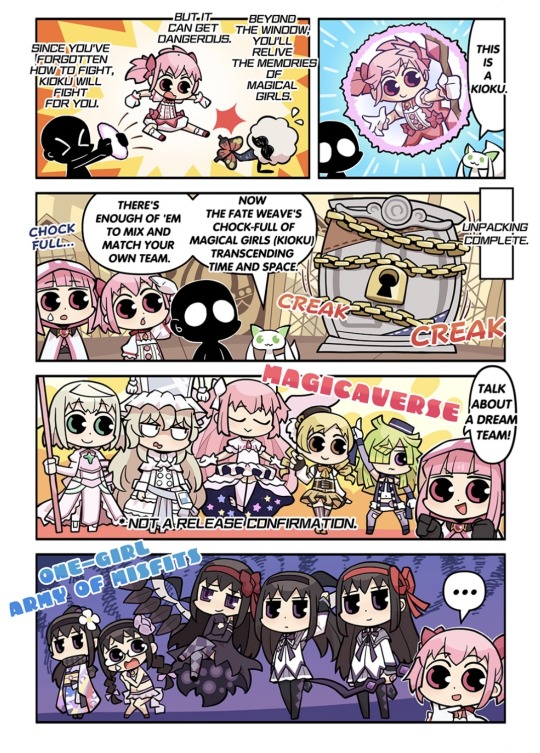
#madoka magica#madokamagica#pmmm#anime#puella magi madoka magica#magia record#gacha game#magiarecord#magical girl#magical girls#mabayu aki#madoka kaname#homura akemi#madoka magica exedra#magia exedra#a-q#Jeanne d'Arc#Tart#oriko mikuni#iroha tamaki#Name#mami tomoe#Magia Et Cetera
101 notes
·
View notes
Text
Nome: Angélique Vivienne Grimaldi
Idade: 29 anos
Como gostaria de ser tratado: Vossa Alteza está bom
Área de atuação no outro mundo: Engenharia Biomédica com foco em Próteses e Órteses
Habilidades extras: diplomacia, atividades filantrópicas, liderança e gestão, planejamento de eventos, programação de sistemas e robôs
Adaptação com a magia, até então, em uma escala de 0 a 10: 10
Pretensão salarial: $$$+
#lostoneslinkedin#abram alas p essa chacota#ela é zero adaptada com a magia ; tá mentindo msm#* / INTERESTED IN EVERYTHING AND NOTHING ELSE [ et cetera. ]
6 notes
·
View notes
Text
Deuses Ctônicos e Seus Epítetos - Hécate
Continuando nossa série sobre os epítetos dos Deuses Ctônicos, trazemos hoje a poderosa Deusa da feitiçaria, encruzilhadas, protetora dos lares e guia das almas para o além - Hécate.
Geralmente retratada como uma jovem moça vestindo um himation ou chiton, a Deusa é frequentemente identificável por seu par de tochas, pela companhia de cães ou pela representação com três corpos encarando uma direção diferente cada uma. Seus animais sagradas são o cão, a serpente e a doninha.
A figura icônica de Hécate é uma das mais reconhecíveis no meio pagão graças a sua associação na antiguidade tardia com a feitiçaria. Descrita como uma Deusa de amplos domínios por Hesíodo, Hécate é uma Deusa de aspectos tanto ctônicos, como urânicos e marítimos, conhecida por ter uma parcela de domínio em cada um destes reinos, além de ser considerada uma psicopompa (uma guia das almas, como Hermes).
Na era helenística e romana Hécate ficou conhecida por ter seu nome associado a cultos de mistério, construção de katadesmoi (tábulas de maldição) e por ser a Deusa favorita dos usuários de magia. Aqui daremos preferência a seu aspecto no período clássico, principalmente.

O culto de Hécate tinha poucos santuários no mundo antigo, sendo mais cultuada em pequenos altares presentes nas casas que supostamente ofereciam proteção para os moradores dos lares contra magia nociva e fantasmas. Seus maiores centros de culto histórico estavam em Êleusis, onde era cultuada ao lado de Deméter e Koré, além da região da Samotrácia.
EPÍTETOS DE CULTO
Perseis (Περσεις) - "Filha de Perses", relativo ao fato de Hécate ser retratada na mitologia como filha do titã destruidor, Perses, junto a Astéria, a titã das estrelas.
Brimô (Βριμω) - "A Terrível", aspecto de Hécate descrito como monstruoso e ctônico. Medéia a chama assim durante seus rituais nefastos e refere a seu domínio sobre as assombrações do Mundo Inferior. Também é um título de outras deidades, como Deméter e Koré.
Aidonea (Αιδωναια) - Forma feminina do epíteto Aidoneus, de Plutão, o Rei do Mundo Inferior.
Trimorphis/Trioditis (Τριμορφις/Τριοδιτις) - "De três formas/Três caminhos", o epíteto aqui retrata o domínio de Hécate sobre as encruzilhadas e seu triplo aspecto.
Enodia (Ενοδια) - "Das estradas/dos caminhos", o epíteto Enódia se refere originalmente a uma Deusa separada e representa seu domínio sobre os caminhos, espíritos e feitiçaria. Ela foi sincretizada e identificada com Hécate ao longo dos séculos, eventualmente se tornando um de seus epítetos.
EPÍTETOS POÉTICOS
Niktipolos (Νυκτιπολος) - "Andarilha da Noite", descreve o caráter noturnal da Deusa. Em suas passagens pelo mundo dos mortais, Hécate guia as almas adiante. O cães latem sentindo sua passagem.
Atalos (Αταλος) - "Gentil"/"Suave"
Skilakagetis (Σκυλακαγετις) - "Líder dos Cães", os cães são bastante associados a Hécate e considerados sagrados a Ela. Em seu culto na Trácia, alguns eram sacrificados em sua honra.
Kourotrophos (Κουροτροφος) - "Nutriz de Jovens"/"Cuidadora", descreve o aspecto da Deusa como cuidadora dos mais novos.
Chthonie (Χθονιη)/Anassa Eneiroi (Ανασσα ενεροι) - "Ctônica"/"Rainha dos que estão embaixo", ambos descrevem seu caráter e domínio ctônico.
Ourania (Ουρανια)/Einalia (Εἰναλία) - "Celeste"/"Marítima", ambos epítetos descrevem as outras qualidades de Hécate enquanto Deusa com domínio sobre céus e mares.
Phosphoros (Φωσφορος) - "Portadora da Luz", indica sua qualidade como guia e portadora de tochas, seu símbolo mais recorrente.
Uma Deusa com amplitude de domínios, Hécate têm inúmeros epítetos que apenas aumentam conforme descrevemos mais de seu culto após o período clássico, sendo bastante cultuada nos períodos helenístico e romano enquanto era bastante sincretizada com uma miríade de Deusas: Selene, Ártemis et cetera.
Seus mitos mais antigos narram as honras e domínios que recebeu dos Deuses titãs e do respeito que Zeus tem para com Ela, assegurando seus domínios nos céus, submundo e no mar. Ela também acompanha e auxilía Deméter na busca por Koré.
Inspirados pela passagem de Aristófanes que descreve o banquete mensal que é ofertado a Hécate, os helênicos ofertam o Deipnon para Ela e os espíritos errantes na Lua Negra.
Poderosa, de amplos domínios e sendo uma presença inegável, Hécate guia almas para o além e nos oferece proteção contra toda sorte de malefício. Que a Deusa das encruzilhadas e feitiçaria seja sempre propícia, nos protegendo e guiando!
Encerramos aqui o post com seu hino órfico, traduzido por Alexandra Nikaios:
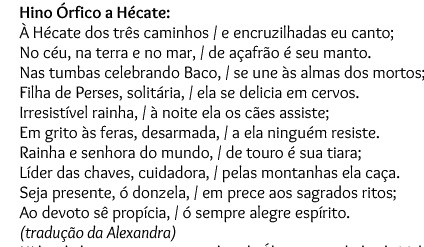
86 notes
·
View notes
Text
Blog Masterpost
Looking for references for:
Magia Record anime casual outfits (better refs)
Kirara Magica manga outfits (excluding oneshots), volume 17 onwards
SLOT 1, A, Rebellion, Movie, magireco outfits
Characters:
O - Madoka - Ultimate Madoka - Homura - Glasses Homura/Moemura - Devil Homura - Mami - Sayaka - Kyoko - Nagisa - Hitomi - Other characters - O
O - All characters masterpost - O
Anime:
O - Original anime - Rebellion - Concept Movie trailer - Walpurgisnacht Rising/Walpurgis no Kaiten - Magia Record Anime - O
Manga:
O - Manga (including reprint) - Rebellion manga - The Different Story - Wraith Arc - Kazumi Magica - Oriko Magica - Extra Story - Sadness Prayer - Suzune Magica - Tart Magica - Magia Record manga - O
O - The Veranda of Madoka - Homura Tamura - Sute Ma! - Welcome to Cafe Grief Seed - Mitakihara Anti Materials - Pomu Magi - Mitakihara Kindergarten - Mami Tomoe’s Everyday Life - Mahou Shoujobu - Floating Madoka - Kanameke - Magia Report - Magia Et Cetera O
Video Games:
O - Portable - Mobage - Plus - Online - The Battle Pengtagram - Mobcast - Magia Record - SLOT - SLOT 2 - SLOT A - SLOT Rebellion - SLOT Movie - SLOT Magireco - Magia Exedra - O
Merchandise:
O - Precious Memories (TCG) - LAWSON - General merchandise - O
Style:
O - Uniform - Magical girl - Pyjamas - Swimsuit - Kimono - Casual - Fancy - Winter - Halloween - Christmas - Cultural Dress - Apron - O
Colour:
O - Red - Orange - Yellow - Green - Blue - Purple - Pink - White - Brown - Black - Grey - O
O - General other - Social media art - Crossover - Concept Art - Weapons - O
36 notes
·
View notes
Text
I’ve been thinking if maybe Alina and Sana were meant to be more, like, connected? More, opposite?
I mean, the story was most likely rewritten, at some point. I can’t help but think that maybe Sana was meant to have a darker side?
I mean, we can kind of see glimpses of it here and there? Her book of torture and a bunch of voice lines for her seem to point at a bit more than just melancholy/pessimism, for example:
Iroha, say you'll always be my friend. Promise me, please! Okay? Okay?! Oh...am I being too clingy? Sorry, but...please promise!
I was also thinking about the “I'm gonna rip those teeth right out of your mouth!” line, but I’m not 100% sure about it.
Her Doppel summon line is also a lot deeper than most of her other lines... And the Doppel itself is unusually gory and has a clear theme of torture devices (the latter can be found in her Magia as well), AND it has two forms, which is unseen in any other Doppel (I think?). I’m also wondering if her last name ties to this as well, the first kanji of it meaning two...
If that was true, then that version of Sana would probably be “overall kind, with a more hidden cruel side to herself”.
Alina, on the other hand, is “overall cruel, with a more hidden kind side to herself” (though I think she was meant to be less the “crazy” sort of cruel, and more of the “cold” type, originally? I’m mostly basing myself off the game’s intro with her saluting, and her overall... Sort of military/police-like aesthetic? She was originally supposed to use a whip, from what I’ve heard...)
Also, it was originally pointed out by @sibainu_oyogu on Twitter, but their character designs are sort of opposite, while also similar? I’ll leave the link to the post, but it points out some contrasts between them, like eye shape, whether or not their hands are covered, Sana having more teal hair and green eyes while Alina being opposites, wavy/straight hair, et cetera.
Here’s the link!
twitter.com/sibainu_oyogu/status/1229721305290702849/photo/2
They were also introduced in the same chapter, so... I don’t know where I’m going here, sorry! It could be pretty interesting, but I do think that the parts of Sana that may have been deleted may have fallen into some ableist tropes, I guess... Maybe it’s for the better.
43 notes
·
View notes
Text
(re)Watching Magia Record S1 - part 7
part 6 here
Hello everyone and welcome back to this quasi-watchalong of Magia Record season 1! Last time, Iroha met a magical girl mercenary called Felicia, and the two ended up caught in the Rumor of the Lucky Owl Water. When our girls went to erase it, a cult group of weirdos called The Wings of the Magius stood in their way and got Felicia to join them promising the extinction of all witches.
Who are these weirdos? What are they up to protecting the Rumors? Is what they promised Felicia true? Et cetera, et cetera. Let's just go to the episode to find out already.
Puella Magi Madoka Magica Side Story: Magia Record S1 episode 7
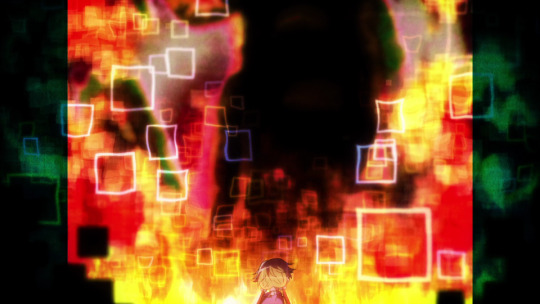
O-oh... what a way to start an episode, huh.
We get a look into what led to Felicia becoming a magical girl and, like most magical girl backstories, it's tragic. This is the reason why Felicia's obsessed with destroying all witches.
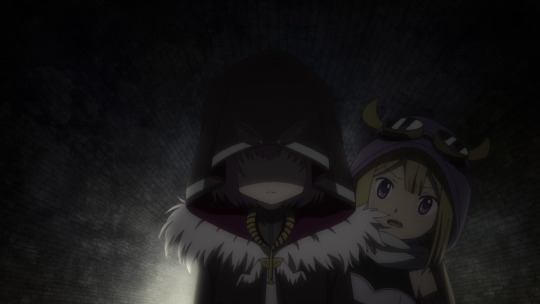
Continuing from the previous episode, Felicia was taken to a subterranean waterway, that might be their hideout. Wait, didn't Kaede say something about a rumor of a giant underground empire some time back? She might've been right after all hahaha
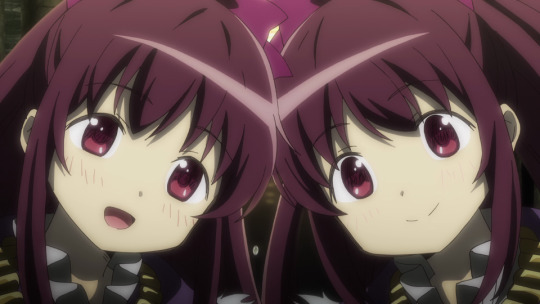
After walking a while, Felicia is met by Tsukasa and Tsukuyo Amane, two of the, uh, generals I guess I could say, of The Wings of the Magius.
The weirdo twins explain that their organization's objective is fulfilling the wishes of the Magius, whose objective is the salvation of all magical girls. See, so they are the ones behind the salvation propaganda.
The twins say their objective cannot be completed without the eradication of witches, which... well, is not a lie. Without the witchfication, there would be no witches. It's all fine until there, but then they're also protecting Rumors, who kidnap people, so... yeah.
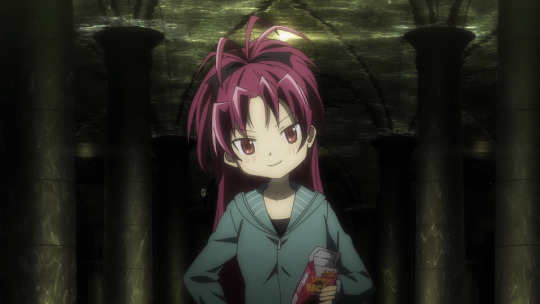
...uh, hey, Kyoko? What are you doing here?
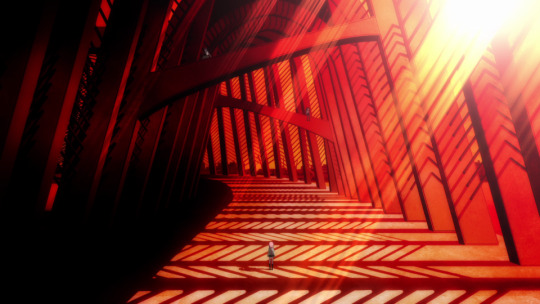
Back to Iroha's group, Iroha is worried about just letting Felicia go like that, to which Yachiyo answers it's fine because she planted a GPS on her... sasuga, Yachiyo. Why in the heck did you have that?
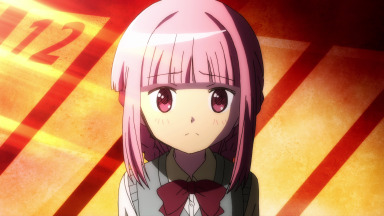
"Am I being tracked too...?”
Yachiyo says this much is normal (no it's not), since she didn't trust Felicia to begin with, but Iroha just feels bad knowing Felicia's circumstances.
The trio heads towards Felicia's position and find the entrance to the waterway. Waiting for them there was...
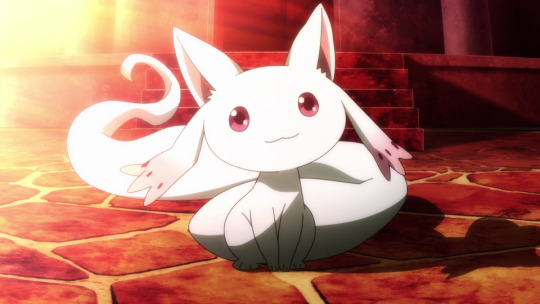
Chibi Kyuubei. For as adorable as he is, he manages to look even more suspicious than the original. And he only shows up when there's a rumor around, too! I don't trust him.
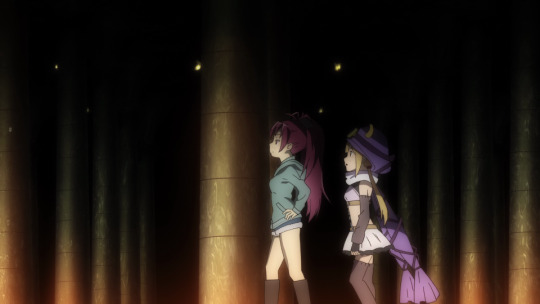
Back at the underground waterway, Kyoko and Felicia are having a little chat. According to her, Kyoko only just ran into them too. She says that as long as she has Grief Seeds, food and a place to sleep, the rest doesn't matter, but she also seems to be aware that the WoM are fishy. Felicia agrees uneasily, but hearing that they might be behind the witches gathering in Kamihama seems to already have put doubts in her mind.
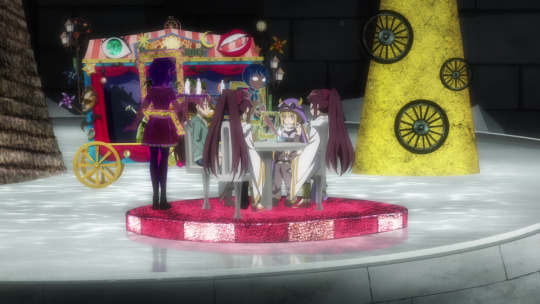
The two have a meeting with the Amane twins inside the Rumor's barrier.
The twins explain the logic behind the Lucky Owl Water once again, and Kyoko says this
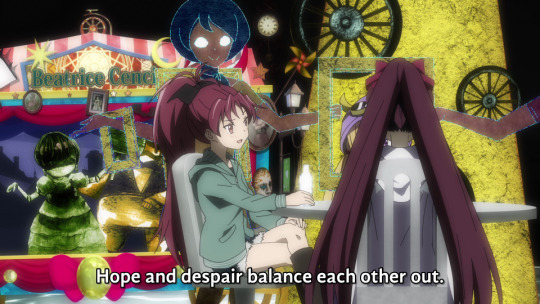
There it is! This series' core. Funny hearing that from Kyoko, since I think she doesn't even know how right she is yet.
Kyoko rejects the Water and lays out her terms: as long as she can keep gathering Grief Seeds, she's fine with anything. However, the twins affirm that those are not necessary in Kamihama. Normally, I'd say these two are bonkers, but... well, we saw what happened to Iroha and Kaede. These two must know about that too. At this moment, a black feather comes in and interrupts their little show.
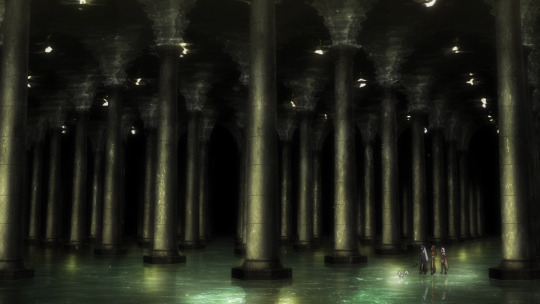
Iroha's group was making their way through the waterway when the Amane twins block their way and, together with them, Kyoko and Felicia.
The Amane twins tell Iroha to do what they say if she doesn't want to be swallowed by bad luck and Iroha asks them why would they create that Rumor, to which the twins once more say it's for the sake of the Magius and their salvation. See, cult.
Yachiyo cuts to the chase and confirms they're here to battle, and the twins pull out something strange on them.
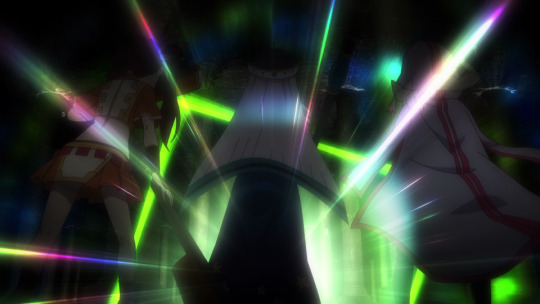
So, yeah. There's pocket monsters, and now we have pocket witches too, apparently.
The twins called a witch upon our girls, which, according to them, they are controlling with magic. As the girls begin fighting against their familiars, Yachiyo asks the twins if they have any idea of what exactly they're doing. Tsukasa apologizes, but affirms that witches will be gone if they can realize their plans. The twins (literally) pull the rug on Yachiyo and Tsuruno and chase after them, leaving the (weak) Iroha to Kyoko and Felicia.
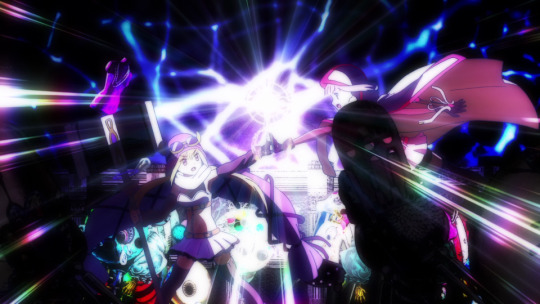
Iroha gets whacked by the familiars and Felicia comes in to help. Iroha then once again dashes in her direction and they do a connect. Upon further thought, I think Iroha's assist is a booster in a more literal sense, since it turned Felicia's hammer into a rocket-hammer. My theory is that it's the same propulsion magic that makes her crossbow work.
Felicia's hammer causes a quake and one of the twins asks what's going on. Well, what did you think would happen if you released a witch in front of someone who notoriously goes berserk when they see witches? The twins might not be very smart.
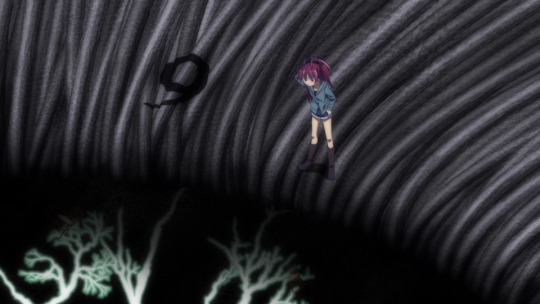
Damn, I missed a number.
Kyoko bounces too. She wasn't very convinced with the twins' vague talk of "salvation".
After transforming, Kyoko does her good act of the day, busting a hole in the barrier and telling Iroha to go on ahead. Iroha hesitates to leave her friends behind but obeys when Yachiyo tells her to go.
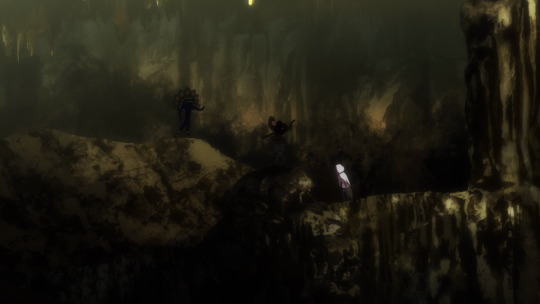
With Kyoko guarding her back Iroha manages to make it out of the witch's p*kéball and into the Rumor's barrier. Like it's said, out of the frying pan into the fire. Oh and there's 7-6. I'm really missing numbers left and right today.
No Iroha, don't go chase the Kyuubei towards the light...! Just kidding. Iroha gets out of the tunnel and finds the Rumor's main body. She confirms with her tutorial mascot if she only has to break that, readies her crossbow and... gets swarmed by owls. C'mon Iroha, did you really think it'd be that easy?
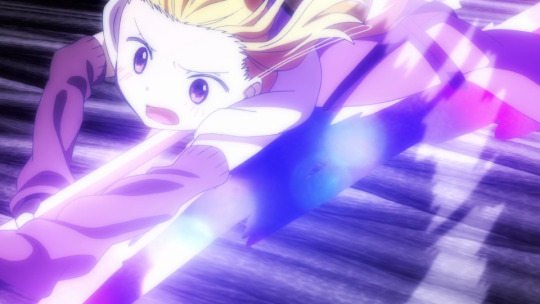
While Iroha's busy sucking at battles, Felicia's not having a better time with her reckless style either. Kyoko saves her ass and tells her she's not winning like that.
This whole sequence is just great in terms of animation, shame I can't really screenshot that T-T
As someone on a similar spot, Kyoko gives Felicia some advice, telling her she's a magical girl for her own sake; that's how it should be when she's betting her own life.
The two cooperate on destroying the witches, with Felicia bonking the whole barrier to smithereens. Nice job, rocket-hammer!
The girls go back to the waterway and the twins' Soul Gem is quite drained. Tsuruno tells them to stop already, but these two weirdos say that's just what they wanted.
Saying that they'll be able to show that Kamihama is a place of salvation, the two do the same thing Iroha and Kaede had done.
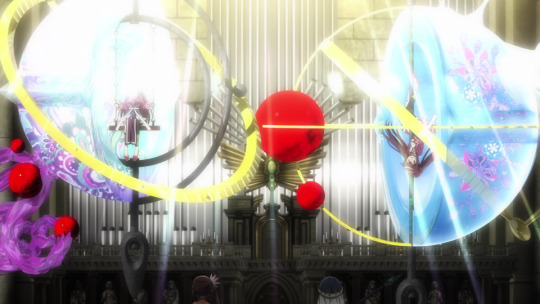
Uhhh... if the salvation that the Magius is preaching is spewing out a witch from your body, that's already super fishy. There's no way there's no downside to this. This is Madoka we are talking about... right...?
While Yachiyo's group learns a shocking and disturbing truth, Iroha's busy getting her ass kicked. Poor Iroha
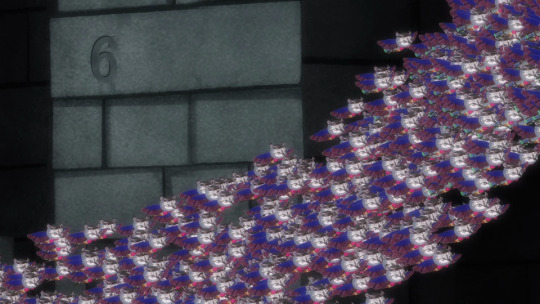
and oh god, I don't think anyone would ever catch this number if they weren't pausing as much as I am to write this.
Iroha keeps getting wrecked by the owls, miraculously escaping unscathed thanks to the Lucky Owl Water. As the numbers keep counting down, Iroha starts questioning what happened to her back in the Seance Shrine. Uh, Iroha, is this really the best time to be introspecting?
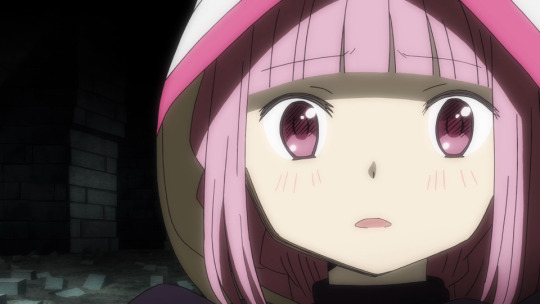
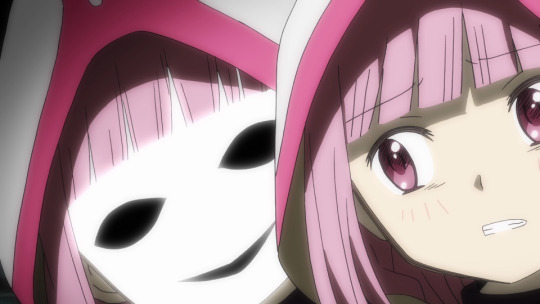
No matter how many times I see it, this scene still creeps me out.
While Iroha gets another round of spawning a witch, Yachiyo's group fight the twins', to no avail. Back to Iroha...
Oh no the witch talks now? Eek... oh, wait wait is this still Iroha's voice?
Not that the first thing it said is wrong, but Yachiyo's words really remained in a negative manner, huh? First in the Seance Shrine and now this. Iroha, don't go getting yourself killed trying to become stronger, ok?
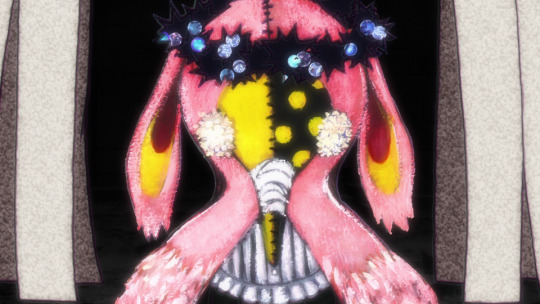
A-at least it's a bit cuter now... if you can call a witch that... rather, why did it change?
Iroha's thing makes short work of the Rumor and the Chibi Kyuubei peaces out. As if it wasn't suspicous enough, it turns into freaking water. Goddammit Chibi Kyuubei.
Iroha just lies there tired.
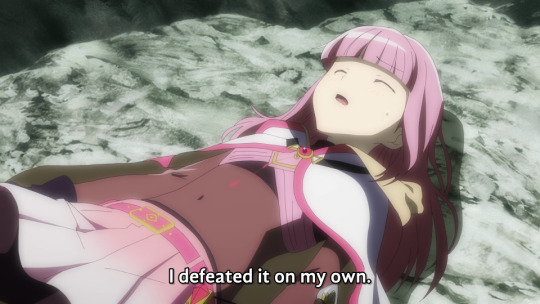
Uhh... yeah, sure, if you count an eldritch abomination coming out of you as part of yourself, then yeah you did.
Like last time, Iroha's Soul Gem is pristine clean now.
Back to the twins, thanks to the floating water falling they realize that the Rumor's been defeated , then start panicking.
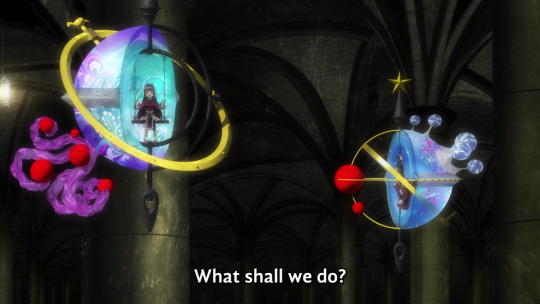
"Someone", whose voice we're already familiar with, comes in to check on the situation and the twins apologize for their failure.
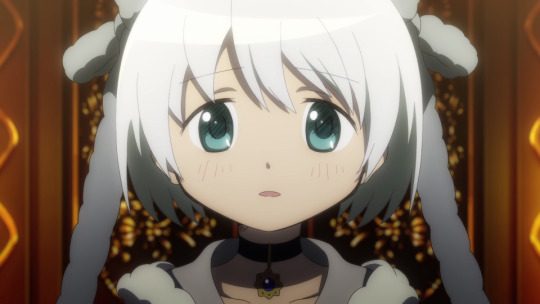
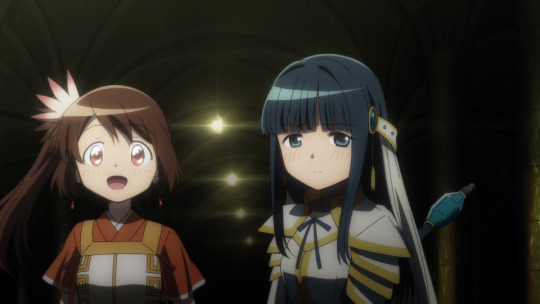
Whelp, this is awkward. Hello there, Mifuyu. So you joined a cult.
Tsuruno gets really emotional. She runs up and hugs Mifuyu. who stops the Black Feathers from attacking her. Tsuruno's really glad that she's back and says they'll have to make a "Welcome Back Party" at her family's restaurant, but Mifuyu says she's not going back, because she's part of the cult The Wings of the Magius now. (couldn't they choose a shorter name for their group? Geez)
Mifuyu shifts her attention to Yachiyo and says she's happy that they went even to Seance Shrine to search for her; Yachiyo says it's thanks to the Kamihama Rumor Files (the notebook Yachiyo carries around) that she left behind.
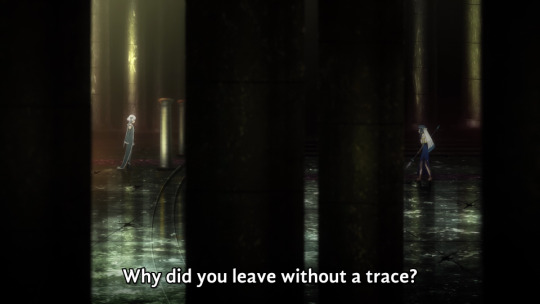
Yachiyo asks but Mifuyu implies she's the one that was left behind.
Mifuyu invites Yachiyo to join the cult but Yachiyo, obviously, can't agree with their methods. She questions if Mifuyu hadn't resolved herself as a magical girl but Mifuyu, like we saw in the flashback, really wants to be saved. Yachiyo's the only one who's strong like that.
Yachiyo says she'll stop her by force if she has to and they prepare to battle again, but Mifuyu uses her magic and has her group leave.
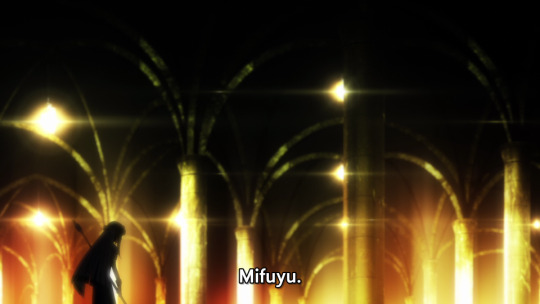
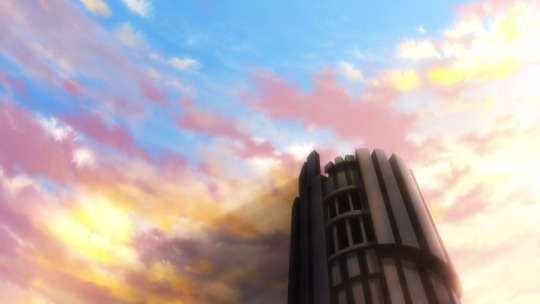
Iroha's group leave the underground waterway (seems Kyoko has gone her way already too). Felicia tries to leave too and says she has nowhere to go back to when Iroha stops her and asks, so Iroha tells her to come over to her place.
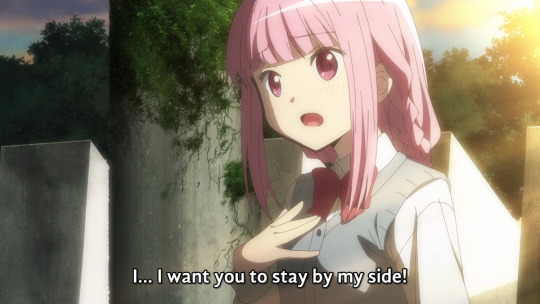
Felicia says she doesn't have to do that for her, but Iroha says she's doing this for herself, that she needs Felicia's strenght. Felicia argues that Iroha will get in trouble again if she's around and all the girls chip in saying they'll help her learn to hold herself back. (I'm not sure what this far framing is doing but I do like how it lets us see the body expression of all the girls at once.)

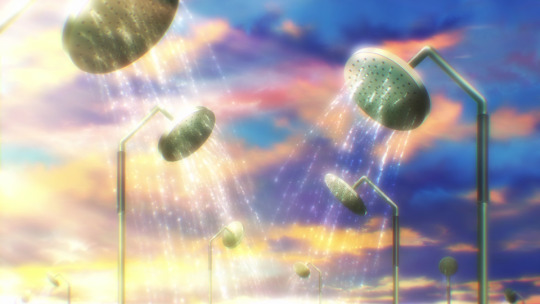
Huh, weird, why is the screen so blurry? I can't type like this...
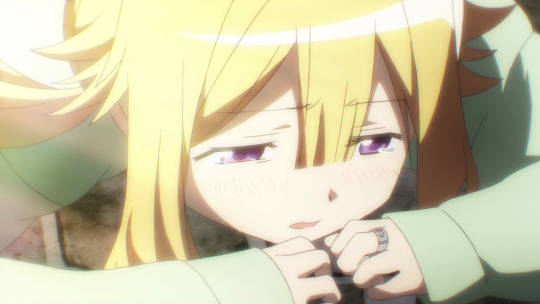
Iroha apologizes for what they said and insists on having Felicia over, even if just for the day. Yachiyo comes in and tells them to stay over at her place instead.
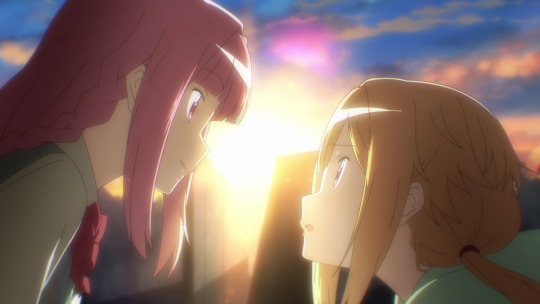
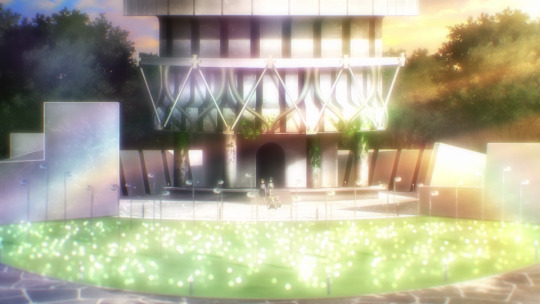
*sobs* so beautiful ;-; I wish I knew the name of the ost track here it's really pretty too.
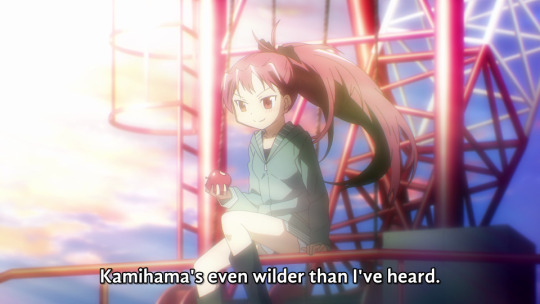
It really is Kyoko, it really is.
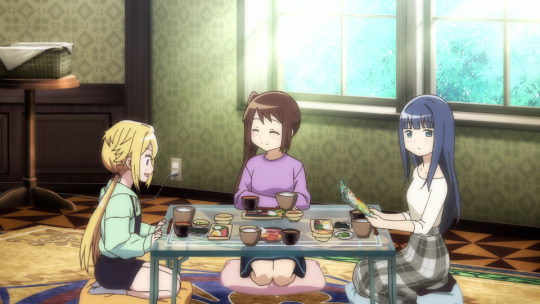
At Yachiyo's place, Iroha's on the phone with her parents while the others wait for her to eat. It seems like her parents finally decided on where she's going to be moving to, and whatever they said was a surprise.
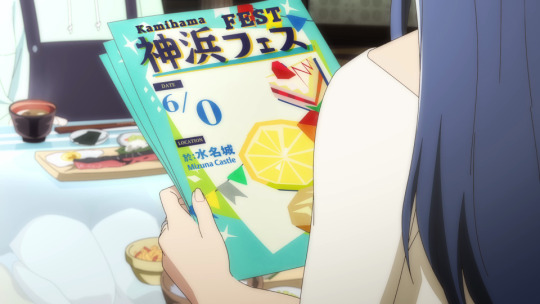
There goes the last number! The Rumor's gone so this has to be purely for the sake of finishing the countdown, but I have long given up on trying to find the ones I'm missing in this episode.

And there's the title card. Don't leave the episode yet, though, as there's still an after credits scene.
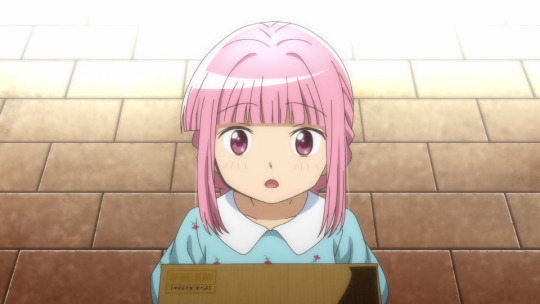
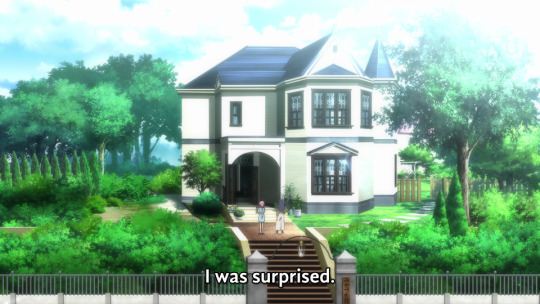
To absolutely no one's surprise besides Iroha's, the place her parents decided on is Mikadzuki Villa, Yachiyo's place. Now, I did say that last number must be purely illustrative, but I'm inclined to agree with Iroha here on it being thanks to the Lucky Owl Water since there is no other way I can rationalize Iroha's parents, from overseas, managing to find the phone number of Mikadzuki Villa, that's not even doing boarding anymore, calling while Yachiyo's around to respond, making an agreement to let Iroha live there, and Yachiyo not even telling Iroha her parents called. So yeah, I say it was the Lucky Owl Water.
Felicia comes with Tsuruno and reveals she's also been living in Yachiyo's place. She's happy she'll be freed from living alone with Yachiyo and her "nagging" and Yachiyo tells her to clean up; Iroha says she's glad to see them getting along.
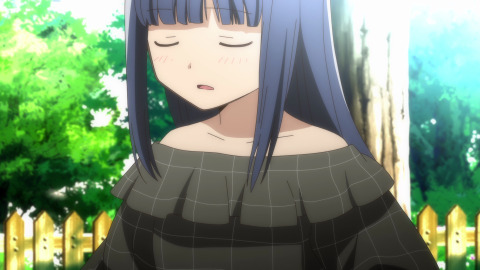
“When did I turn into a mom?“
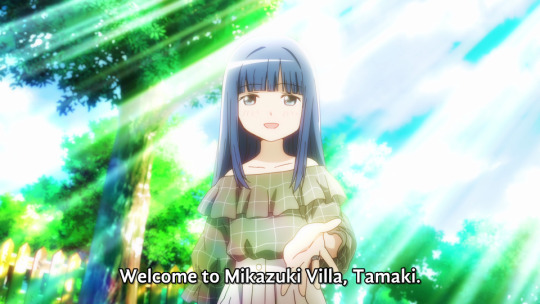
That's a new type of bishie sparkles alright. Can all models do this? Is it like some special ability like Gabs' censor light rays? We'll never know.

After the various types of ad, now we have spam too. Magia Record is actually warning us about the dangers of the internet.
...In all seriousness though, that's some mysterious text. How do they, whoever "they" are, know that Iroha's a magical girl? And most of all, how do they have her number? Guess this is going to be the mystery for the next episode. (Also, I never noticed this before but you can hear a veeeery quiet chime when the messages come in. Nice detail!).
- x -
Aaaand with that, we have concluded episode 7! This one also ran on longer than I expected and, surprisingly, managed to surpass the number of screenshots of all others at about 43 images. sugoi
I couldn't catch all the numbers this time, but the ones I did were: 13-12 with Iroha on the bridge; 10-9 when Kyoko "betrays" the WoM; 7-6 when Iroha finds the Rumor; 6 through 1 happen while Iroha's fighting the Rumor and the last 1-0 was in Yachiyo's magazine. With that, I'm missing 12-11; 11-10; 9-8 and 8-7, which I have no idea where they are. Oh well.
I realized partway through that it kinda seems like I'm dissing Iroha every chance I get, but I assure you I don't hate her. In fact, she's my favorite character! This is coming purely from a place of affection, and a bit of frustration at what the anime did to her character, so don't mind me, it's aaall good.
With that out of the way, this was episode 7! We are now over halfway through, with a buckload of mysteries and barely any progress being made towards finding Iroha's younger sister. Poor Ui, if you even existed. Tomorrow, we'll be watching episode 8, so I hope you'll read me again then. Have a great morning/afternoon/evening and see you later!
4 notes
·
View notes
Photo

EGRÉGORA E SEU MODUS OPERANDIS 1. Definição Egrégora pode ser usado tanto feminino por terminar com a letra “a” ou no masculino por se referir à palavra “grupo”. O termo tem sido amplamente usado para representar tantas coisas diferentes que quando paramos para pensar o que realmente é uma egrégora, não chegamos a uma conclusão clara. Será possível encontrar sua origem na palavra em Latim “aggregare” que significa reunir, congregar; e também do Latim “egregor” que significa ‘observador'. Sendo esse último usado no livro de Enoch e na Bíblia (como anjo) em diversas passagens de Daniel e também é o mesmo sentido usado por Levi. Apesar disso, é mais comum ver a aplicação do termo para caracterizar: - Uma forma pensamento de um grupo (qualquer agremiação formal ou informal); - Um ente formado pela ação comum de membros de um grupo; - Um grupo de espíritos protetores (dirigentes) de uma atividade espírita. Portanto, de forma geral, pode-se concluir que egrégora refere-se ao fenômeno produzido pela interação de pessoas envolvidas num objetivo comum, isto é, a produção de uma “forma grupo” numa dimensão sutil que cuida dos interesses deste grupo, por exemplo, empresas, clubes, religiões, famílias, partidos et cetera. 2. Na História Quando pensamos em egrégora, a primeira ideia que nos vem à mente é ser algo relacionado com grupos relacionados com espiritualidade. Mas W. E. Butler em seu livro ‘The Magician, his training and his work', de 1959, foi mais específico e escreveu: “Uma clara ideia da natureza da egrégora mágica, ou forma grupo, deve ser construída na mente no intuito de que o aspirante possa entender que parte ele desempenha em todo um complexo esquema e pelo qual pode saber o quão de perto ele é guiado e ajudado no trabalho escolhido.” Definitivamente, o termo egrégora foi colocado em voga pela Sociedade Teosófica, no início do séc. XX, se apoderando dele ao se referir ao grupo de seres mais evoluídos que são responsáveis pela condução da evolução da humanidade, a Grande Fraternidade [Loja] Branca. No entanto, o termo tem uso mais antigo e pode ser encontrado em ordens iniciáticas e círculos religiosos: - Templários, na imagem do Baphomet; - Maçonaria com a “Cadeia de União”; - Teosofia com os Mahatmas; - Golden Dawn com os Mestres Secretos; - Fraternitas Saturnis com Gotos; - AMORC com o Sanctum Celestial (Hierarquia); - Espiritismo com seus Guias; - Umbanda e os Eguns; - Catolicismo com Jesus e os Santos; - Candomblé com os Orixás. Nos séculos XVIII e XIX, o termo egrégora recebeu maior atenção dos escolásticos da época e tornou-se algo mais técnico, isto é, recebeu uma abordagem mais específica, voltada à magia. 3. Na Magia As egrégoras podem ser classificadas em dois tipos básicos, a intencional e a casual. A egrégora intencional surge como resultado da interação de diferentes pessoas envolvidas num propósito “específico”. E nesse caso, a egrégora funciona como um animal adestrado que servirá ao propósito de quem a criou, sempre muito obediente, protetora e pró-ativa. Mas sempre constituída propositalmente. Já a egrégora casual é formada sempre que as pessoas se reúnem para fazer algo e a menos que algo seja feito para mantê-la, ela se dissipará tão rapidamente quanto o grupo se desfaça. No entanto, caso desejem que sejam mantidas, será é necessário conhecer certas técnicas de como o fazer, e a egrégora continuará crescendo em força e podem durar durante séculos. As egrégoras intencionais estão relacionadas às atividades espirituais ou esotéricas coletivas, sendo que as características básicas e essenciais de tais grupos são: - que possuem um propósito claro e bem definido; - que congregam pessoas em torno desse propósito; - que elegem uma liderança ao grupo; - que escolhem um símbolo para caracterizar esse propósito; - que consagram esse símbolo por “cerimônia” e na presença do grupo e seu líder; - que mantém reuniões regulares para tratar do propósito; - que revezam seus cargos e/ou postos regularmente. Como disse, todos esses elementos são essenciais para a constituição de uma egrégora. Mas note que os itens 3, 6 e 7 são os de maior importância na manutenção de uma egrégora como mostrarei mais adiante. A vantagem de se ter uma egrégora está nela ter uma ação mais constante que a soma de seus membros individualmente, isto é, ela age pelo propósito original 24 horas sem qualquer interrupção. Isso sem mencionar que por estar numa dimensão sutil, é capaz de antecipar alguns eventos que poderiam desferir algo contra um dos seus. Ela interage continuamente com seus membros, influenciando-os e sendo influenciada por eles. Geralmente essa interação costuma ser de forma positiva, estimulando e ajudando seus membros, basicamente por intuição, sonhos e por outras faculdades que o membro venha a possuir, desde que estes ajam conforme o propósito original. Sua ação estimulará todas as faculdades do grupo que permitirão a realização dos objetivos, individual e coletivamente, de seu programa original. Se esse processo for continuado por muito tempo a egrégora toma vida por si própria, e pode ficar tão forte que até mesmo se todos seus membros morressem, ainda continuaria existindo por algum tempo, podendo ser reavivada posteriormente. Sendo que o reavivamento de uma egrégora depende da capacidade de se viver como os fundadores originais, particularmente se estão dispostos a fazer a “contribuição inicial” de energia para fazê-la começar novamente. De qualquer maneira, o reavivamento de uma egrégora é um ato consciente e intencional, cujo preparo passa pelo processo descrito anteriormente. 4. Manutenção Uma egrégora traz benefícios, mas como tudo na vida, também traz certa carga para sua manutenção. Independente de ela ser casual ou intencional, uma egrégora é como qualquer "entidade astral", i.e., necessita de “alimento” para seu sustento (existência) e suporte do propósito de sua criação. A egrégora se “nutre” basicamente dos elementos que a criou, como qualquer ser vivo, quer dizer, das emoções, pensamentos e outros materiais “devotados” à sua criação. Está na base instintiva da natureza, pois tudo que ganha vida luta por mantê-la (lei da sobrevivência). E com a egrégora ocorre a mesma coisa. Além disso, ela possuirá psicologia, intensidade e personalidade herdada dos próprios criadores, um amálgama. A “alimentação” da egrégora ocorre durante os encontros regulares do grupo. E no caso dos grupos espiritualistas ou iniciáticos, mais especificamente em seu ritual e/ou cerimonial regular. Funciona como uma recarga que é retirada dos membros, aos oficiais e sendo canalizada destes ao líder do grupo à egrégora. Nesse momento, novos pedidos e objetivos podem ser imputados à egrégora. No final de um período previamente combinado, os oficiais de tais grupos devem revezar seus cargos. Essa é uma contra medida de segurança importante para que a egrégora não se vicie. 5. Efeitos Colaterais Pode ser que o grupo se disperse por diversas razões ou mesmo seus líderes comecem a agir contra o objetivo original, ou ainda, os oficiais permanecem no mesmo cargo por muito tempo. No primeiro, caso seu “alimento” lhe seja suprimido: - a egrégora tenta influenciar os membros para retornarem às atividades; - caso não tenha êxito, começará a influenciar seus líderes mais intensamente; - caso não tenha êxito, haverá a possibilidade da egrégora: - - ou definhar-se até desaparecer; - - ou ocorrer o "efeito vampiro", quer dizer, dela se tornar "obsessiva" e passe a atuar como um cascão. Por isso, é extremamente salutar o revezamento dos cargos, especialmente para grupos religiosos, místicos ou iniciáticos. Nesses casos, e por segurança, a troca dos oficiais ocorre nas cerimônias de equinócios. No segundo caso, a egrégora tentará motivar o líder para continuar no propósito original. Caso ela não obtenha sucesso, começará a excluir o dito membro do grupo. Portanto, ao assumir a liderança de um grupo, que o líder não negligencie suas funções mais sutis. No terceiro caso, se os oficiantes não forem periodicamente renovados, pode ser criada certa dependência da egrégora. 6. Possíveis Perigos Como disse antes, uma vez que algo ganha vida, este algo lutará para continuar vivendo. E uma egrégora (assim como a larva astral) não é diferente. Portanto, uma vez iniciados, os rituais devem ser executados com certa regularidade. É muito comum, nos tempos atuais, ver grupos surgindo a esmo na mesma velocidade que encerram suas atividades. No entanto, encerram suas atividades por dispersão dos membros, não encontrando tempo de encerrar devidamente seus trabalhos. Nesses casos, a egrégora continua ativa mesmo tempos depois. A egrégora começará a “pedir” alimento, como um “cão sem dono”, aos mais próximos. Isto é, às cabeças do grupo e se não tiver sucesso, aos demais membros. A egrégora agirá exatamente como um obsessor ou cascão astral, sendo que mais fraca, pois sua natureza é diferente. Tentará influenciar o retorno das atividades do grupo a partir de um membro. 7. Observações e Devaneios Geralmente não conhecemos o processo de sua criação. As egrégoras vão sendo criadas a esmo e os seus criadores logo se tornam seus servos já que são induzidos a pensar e agir sempre na direção dos elementos que caracterizaram sua criação. Serão tão escravos quanto menos conscientes forem do processo. Se conhecerem sua existência e as leis naturais que as regem, podem se tornar senhores dessas forças. Submetamos Thelema ao processo descrito anteriormente. Há algum símbolo que seja o ícone de Thelema, pelo qual seja possível se trabalhar regularmente? Sim, vários, mas existe algum em especial? Em THELEMA não, mas nas Ordens Thelêmicas sim. Observe as festas e cerimônias recomendadas em Liber AL. Portanto, não há egrégora para Thelema, porque não há o elemento básico que é um evento cíclico e um ícone de “veneração” como ponto de apoio, tal como o Catolicismo com Jesus Cristo. Na A∴A∴ a coisa fica mais difícil ainda, é uma ordem individual, não há como haver egrégora. Os Mestres Secretos são outra coisa diversa de egrégora. O “efeito vampiro”, como já foi comentado, é como um obsessor ou cascão astral, e caso ocorra, deve ser banido como tal. Apesar de agirem de forma parecida, não confundam egrégora com um obsessores. Os obsessores se “alimentam” de sentimentos de revolta e ódio, exige mais revolta, ódio e sentimentos afins, enquanto que a egrégora se sustenta pela congregação de seus membros e só atuará como obsessor se for por sobrevivência. Como todo ser vivo, uma egrégora não quer morrer e cobrará sua subsistência aos seus genitores, induzindo-os a produzir, repetidamente, as mesmas emoções. Caso tentem eliminar uma, façam sem hesitar. Pois do contrário, a egrégora achará um ponto fraco para se manter. Notas do Autor Esse texto foi desenvolvido a partir de anotações iniciadas em abril de 1997, sendo alterado conforme novas descobertas até 2004 quando foi encerrado. Minhas principais fontes de pesquisas foram: - participação ativa em Ordens que mantém egrégoras - trabalho ativo e direto com obsessores em Centros Espíritas - estudo e treinamento de médiuns - projeção astral individual e grupo - invocação e banimento de “espíritos” - livros, dezenas deles. Frater ABO Fonte do Texto e da Gravura: HADNU https://www.hadnu.org O Hadnu é uma comunidade ocultista focada em Thelema e Golden Dawn.
2 notes
·
View notes
Text
Szkarłat i błękit
Jeżeli ktoś lubi serie-tasiemce (mangowcy wiedzą o co się rozchodzi), tematykę wampirów, urban fantasy i raczej humorystyczne opowieści – na „Księdze Vanitasa” z pewnością się nie zawiedzie. Jednak jeśli będzie doszukiwał się tam głębokich przemyśleń i górnolotnych treści może się sromotnie zawieść, bowiem Jun Mochizuki – autorka „Pandora Hearts” – stawia bardziej na czysto rozrywkowe utwory.
Wampir Noe zostaje wysłany przez swego mistrza do Paryża, gdzie ma odnaleźć mityczną Księgę Vanitasa, artefakt o bardzo potężnych właściwościach. Podczas podróży na pokładzie luksusowego sterowca napotyka pewnego m��żczyznę, podającego się za osławionego – w wampirzym światku – Vanitasa, dodatkowo posiadającego ów magiczny grymuar, który zresztą wykorzystuje do uzdrawiania krwiopijców. Noe, pomimo niechęci, postanawia się do niego przyłączyć, choć jego motywacje nie są do końca znane, poza tym, że pragnie zdobyć tytułową księgę i poznać jej prawdziwą naturę.
Właściwie tomik stanowi typowe wprowadzenie do świata przedstawionego – dostajemy wiele akcji, za pomocą której autorka po trosze zarysowuje portrety charakterologiczne, acz nie wnoszące zbyt wiele do intrygi utworu. Pierwsza część zasadniczo wyznacza kierunki dla dalszych odsłon, otwiera wątki i skupia się na objaśnianiu motywacji, dążeń, obaw, sposobu rozumowania i postrzegania świata przez bohaterów, ale wszystkie te aspekty zostają tutaj jedynie liźnięte, co nie oznacza wcale, że manga jako całość jest niepoprawnie skomponowana.
Niewątpliwie ciekawą stroną komiks jest sztafaż świata przedstawionego – akcja toczy się w alternatywnej rzeczywistości iście steampunkowej, gdzie magia i nadnaturalne zjawiska łączą się z epoką à la wiktoriańska i wynalazkami rodem z XIX wieku oraz przełomu pary, jak mechaniczne konstrukty, charakterystyczna dla subgatunku estetyka et cetera. Wszelakie koła zębate, złożone mechanizmy i maszyny napędzane parą istnieją w uniwersum mangi, lecz póki co czytelnik posiada szczątkowe informacje o modus operandi całego świata. Na pewno wyjątkowe wydaje się podziemie wampirów, które ma swoją własną mitologię, tajemnice i system społeczny, z obrzędowością włącznie.
Szata graficzna – bardzo charakterystyczna dla Jun Mochizuki – jawi się w „Księdze Vanitasa” podobnie do „Pandora Hearts”, adresat otrzymuje schludną, zadbaną kreskę, tworzącą dość przyjemne wizualnie plansza, w których nie brak drobiazgowości oraz szczegółowego tła. Autorka dba także o to, aby projekty bohaterów były dokładne, rozpoznawalne i oferujące indywidualne akcenty; Jun nie stroni również od dokładnego cieniowania i niejednokrotnie korzysta z rozmaitych rodzajów rastra, żeby wypełnić tło bądź części szat, postaci czy innych przedmiotów.
Pierwsza część nowej serii Jun Mochizuki zapowiada się całkiem obiecująco, zważywszy na pytania pozostawione po zakończeniu i kuszący świat przedstawiony. Jednak na razie trudno mówić cokolwiek o bohaterach oraz możliwych celach ich podróży. Bardzo intrygująca komedyjka pełna jest humorystycznych scenek i dynamicznej akcji, dzięki czemu komiks się nie dłuży i zapewnia odpowiednią ilość rozrywki. Czy zatem warto sięgnąć po najnowsze dzieło autorki „Pandora Hearts”? Jeżeli liczysz na przednią rozrywkę – jak najbardziej.
Recenzja dostępna na portalu Bestiariusz.
#Waneko#Jun Mochizuki#Księga Vanitasa#fantasy#fantastyka#manga#komiks#japoński komiks#steampunk#recenzja#opinia#Pandora Hearts
4 notes
·
View notes
Text
Fine Art Photography
What is Fine Art Photography ?
Referred to likewise as "photographic craftsmanship", "imaginative photography" et cetera, the expression "compelling artwork photography" has no all around concurred significance or definition: rather, it alludes to an uncertain classification of photos, made as per the inventive vision of the cameraman. The essential thought behind the class, is that rather than simply catching a sensible interpretation of the subject, the picture taker is expecting to deliver a more individual - normally more reminiscent or environmental - impression. One may streamline this, by saying that artistic work photography depicts any picture taken by a camera where the expectation is stylish (that is, a photograph whose esteem lies fundamentally in its magnificence - see, Esthetics) instead of logical (photographs with logical esteem), business (item photographs), or journalistic (photographs with news or illustrative esteem). (See additionally: Is Photography Art?) Artistic photographs have been utilized as often as possible in composition workmanship (all the more accurately, photocollage), by specialists like David Hockney (b.1937); and in photomontage, by Dadaists like Raoul Hausmann (1886-1971), Helmut Herzfelde (1891-1968) and Hanna Hoch (1889-1979), by Surrealist craftsmen like Max Ernst (1891-1976), by the cutting edge Fluxus aggregate in the 1960s, and by Pop craftsmen like Richard Hamilton. Photographs may likewise be joined into blended media establishment craftsmanship, and gathering workmanship. Today, photography is displayed in a significant number of the best exhibitions of contemporary craftsmanship around the globe.

History of Technical Developments
Created in the early many years of the nineteenth century and the subject of various advances amid the period of Victorian craftsmanship, photography quickly caught more detail and data than conventional strategies for replication, such as painting or model. The specialized development of photography was a piecemeal issue, despite the fact that a noteworthy jump was the revelation of light-delicate emulsions in 1839, empowering cameras to take high contrast photos. Other vital specialized advances ever of, incorporated the accompanying.
Photoetching was created in 1822-5 by the Frenchman Joseph Niepce (1765-1833), who additionally made the primary photo from nature in 1826. Enhancements ( in the decrease of introduction time, the daguerreotype) were found by German Professor Heinrich Schultz (1687-1744) and French physicist Louis Daguerre (1787-1851), in 1837, with Daguerre being in charge of the main ever photo of a man in 1839. In parallel to this, in 1832, the French-Brazilian craftsman and innovator Hercule Florence (1804-79) had formed a comparable procedure, called Photographie, while the English creator and pioneer camera master William Fox Talbot (1800-77) was caught up with developing the calotype procedure, which delivered negative pictures. His 1840s research into photograph mechanical generation prompted the disclosure of the photoglyphic etching process, the antecedent to photogravure. The trial British researcher John Herschel (1792-1871) concocted the cyanotype procedure and was the first to coin the expressions "photography", "negative" and "positive". In 1851, Frederick Scott Archer (1813-57) declared the discoveries of his exploration into the wet plate collodion process, which essentially enhanced the openness of photography for the general population, as did the American pioneer George Eastman's 1884 presentation of move film as a trade for photographic plates. In 1908, the French researcher Gabriel Lippmann (1845-1921) was granted the Nobel Prize for Physics for his enhancements in photographic shading multiplication. The improvement of the photographic procedure was studded with such revelations and innovations, and numerous different advances in photographic glass plates and printing techniques were made amid the nineteenth century.
Victorian types included John Edwin Mayall (1813-1901), who snapped a portion of the soonest photos of Queen Victoria and Prince Albert; Julia Margaret Cameron (1815-79), noted for her photographic pictures and legendary pictures; and Oscar Gustave Rejlander (1813-75), the Swedish cameraman and photomontage master who worked with Charles Darwin on The Expression of the Emotions in Man and Animals.
Twentieth century progresses in photographic innovation have been ruled by enhancements in film and cinematography, prompting new imaginative structures, for example, movement craftsmanship, kid's shows and video workmanship.

Use of Photography in Art
Photography advanced from the camera obscura, an instrument that anticipated a picture through a little gap, enabling the craftsman to make a precise following of a protest or scene. The primary say of its utilization as an attracting help showed up Magia Naturalis, a logical treatise by the Italian researcher Giambattista della Porta. Numerous Old Masters from the seventeenth and eighteenth century, including Jan Vermeer (1632-75), and Canaletto (1697-1768), are accepted to have utilized it in their outlining.
With the spread of camera-photography from 1840 onwards, the utilization of photographs ended up regular in the creation of both representation workmanship and in addition scene painting. Numerous figure painters and portraitists started utilizing the new medium of photography notwithstanding models, to decrease sitting-time. The immense nineteenth century American pragmatist painter, Thomas Eakins (1844-1916), for example, was an eager client of the camera, who utilized photography as a feature of his quest for authenticity, as opposed to as an alternate route or help to sythesis and point of view. Photography was additionally utilized via scene craftsmen - strikingly the French Impressionist painters, as a guide to plein-air painting. For more points of interest, see: History of Art.

Photography as a Fine Art
In spite of the fact that by the late nineteenth century, photography had turned out to be acknowledged in both Britain and America as a minor visual workmanship - due to some degree to the limited time endeavors of magazines like "American Amateur Photographer", and in addition bodies like the "General public of Amateur Photographers", the "General public of Amateur Photographers of New York", the "Photographic Society of Philadelphia", and the "Boston Camera Club" - a few photographic specialists were quick to demonstrate that the new medium could be similarly as masterful as different sorts of craftsmanship, such as drawing and painting. Two such specialists were Alfred Stieglitz (1864-1946) and Edward Steichen (1879-1973). Both were instrumental in making photography a compelling artwork, and Stieglitz specifically (and furthermore his significant other, Georgia O'Keeffe) was in charge of bringing it into gallery accumulations. A point of interest occasion happened in 1902, with Stieglitz's arrangement in America of Photo-Secession, a relationship of imaginative picture takers, and the production of its magazine Camera Work (1902-17), which quickly turned into a gathering for current specialty of different types. In 1905, Stieglitz and Steichen established the "291" display in New York, a setting spend significant time in cutting edge workmanship, prominently photos, artistic creations and figures.
1 note
·
View note
Text
Altares e espaços de culto
Então, você já começou a rezar para as divindades helênicas? Que maravilha. Hora de vermos como separarmos um espacinho para eles!

Parte de ser um helênico desde os tempos antigos é o hábito de construirmos altares para os Deuses, sendo ele um local apropriado para adoração e contato com o divino. Na Grécia Antiga havia dois formatos de culto, o cívico e o doméstico, que em essência se separavam em esferas sociopolíticas e familiares. Hoje em dia dificilmente teremos acesso a um templo dedicado a nossas divindades, por isso a atenção ao culto doméstico deve ser uma primazia.
Uma área de culto (temenos) pode ser parte de nosso começo de culto aos Deuses. O altar, ou a área designada para abrigar suas ofertas, é chamada de bomos - antigamente representado por um bloco de mármore recortado - e o temenos sendo o espaço designado para abrigar os ícones e imagens representativas das deidades associadas àquele espaço. Um dos Deuses ou um grupo deles pode partilhar de um mesmo altar.
Vários Deuses são importantes para a vivência doméstica: Zeus Herkeios, que guarda a propriedade, Apolo Aguieus ( das ruas, cuja representação era uma pedra cônica que marcava a propriedade), Hermes, Hécate, Héstia (cujo espaço sagrado era a própria lareira), o Agathos Daimon e Zeus Ktésios (dos bens). Todos partilhando domínio sobre aspectos da vida doméstica, protegendo os bens dos que vivem na casa contra ladrões (Hermes, Apolo, Zeus), maus espíritos e magia nociva (Hécate, Hermes), e promovendo um espírito familiar sadio de amor, saúde e prosperidade (Héstia, Agathos Daimon e todos os outros).
Ninguém aqui vai demandar que tu acabes cultuando todos os Imortais acima citados, mesmo que o pensamento de poder honrar todos de alguma forma ainda me seja bastante agradável. Comecemos com o básico - os suprimentos e partes de um espaço.
Elementos comuns de um espaço de culto:
Ícone representando a deidade, uma estátua, desenho, imagem impressa ou algo do tipo.
Recipiente seguro para a chama de Héstia, uma vela, um pequeno caldeirão ou outro recipiente que comporte fogo sem problemas de segurança.
Um difusor ou porta-incenso.
Tigela ou outro recipiente para libações (ofertas líquidas)
Prato de oferenda (para ser colocado no bomos) ou outro espaço.
Decorações adequadas de acordo com a divindade (Imagens de cavalos para Poseidon, rosas para Afrodite, instrumentos musicais para Apolo)
Com estes elementos dispostos, é possível formar um altar perfeitamente funcional aos Deuses urânicos, e no caso do altar ser dedicado a um dos Deuses Ctônicos (Perséfone, Hades, Hermes Ctônico et cetera...) o bomos dá lugar a um bothros - uma espécie de cavidade do no solo, o próprio chão era sagrado aos Deuses do Mundo Inferior, por estarem ligados à Gaia (Terra) e sua fertilidade. Suas oferendas podem ser enterradas e despejadas na terra para Eles.
O espaço é um local onde o relacionamento sagrado se dá forma, seja ele temporário (para festivais específicos ou no caso de você estar fora de casa) ou fixo, este é um local sagrado que deve ser preparado para o propósito de entrar em contato com os Imortais. Hoje em dia nem todos poderão começar com grandes altares e tudo o mais - e tudo bem, os Deuses bem sabem como vivemos e quais são nossas possibilidades reais de culto, eu comecei com uma caixinha singela de sapatos ornamentada para Apolo, hoje já tenho meu espaço dedicado.
Tome seu tempo, a dedicação e a construção da kharis com os Imortais se engrandece com o passar dos meses, tu poderás começar de algum lugar - seja um altarzinho de viagem, com uma mera imagem, vela pequena e incenso para ofertas - o esforço de se buscar cultuá-los é belo por si só. E antes algo sendo feito, do que nada.
Não há pressa em buscar a perfeição.
Espero que essa postagem tenha sido útil. Até outra hora! Eirene! (Paz!)
Fontes: Pausânias, Descrição da Grécia. Walter Burkert, Greek Religion. Martin P. Nilsson, Greek Folk Religion. Daniel Ogden, A Companion to Greek Religion.
74 notes
·
View notes